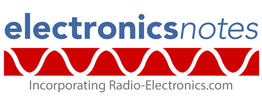Home » Component data » Diode (PN junction) data » this page
1N4448 Diode Data
Key data for the 1N916 semiconductor diode including key electrical parameters, performance, features, outline, package type and many other key datasheet details.
The 1N4448 is a faster lower capacitance of the very popular 1N4148 or 1N914 diode.
Described as a small signal diode in some areas it is also termed a fast switching diode in others.
Whatever the descried the 1N4448 is a very useful diode that can be used for many small signal applications.
Key details and performance parameters for the 1N4448 diode.
| 1N4448 diode datasheet parameters & data |
|
|---|---|
| Parameters | Details |
| Diode type | Small signal fast switching PN diode |
| Package type | DO35 & miniMELF SOD80 |
| Repetitive peak reverse voltage, VRRM | 100 V |
| Working peak reverse voltage, VRWM | 75V |
| DC blocking voltage, VR | 75 V |
| RMS reverse voltage, VR(RMS) | 75 V |
| Forward continuous current, IF | 300mA |
| Average rectified current, IF | 200mA (half wave rectification with resistive load) |
| Non-repetitive forward surge current, IFSM | 75 V |
| Reverse leakage current, IR | 0.025µA for 20V reverse voltage |
| Power dissipation, PTOT | 500mW |
| Junction temperature (°C) | 175 |
| Forward voltage VF | 0.73V max for 5mA IF |
| Breakdown voltage VBR | 100 V min. |
| Reverse leakage current, IR | 0.025µA for 20V reverse voltage |
| Diode capacitance CD | 2pF for VR = 0 |
| Reverse recovery time | 4ns |
Outline & pinout:
Explanation of major diode parameters
| Parameter | Explanation |
|---|---|
| Repetitive peak reverse voltage, VRRM | This is the maximum value of the short period peak reverse voltage that can be sustained. |
| Working peak reverse voltage, VRWM | This is the maximum value of the continuous reverse voltage that can be applied to the diode. |
| DC blocking voltage, VR | This is the maximum reverse DC voltage that should be applied across the diode. |
| RMS reverse voltage, VR(RMS) | As many AC waveforms are quoted in RMS, this is the maximum reverse voltage that can be sustained where the voltage is expressed in terms of its RMS value. |
| Forward continuous current, IF | This is the maximum forward current that can be sustained by the diode. |
| Average rectified current, IF | This is the maximum average current value that can be handled by the diode. The parameter often states the load as this will affect the operation of the diode. |
| Non-repetitive forward surge current, IFSM | This is the maximum surge current that can be handled - it should only be present for a short time. |
| Parameter | Explanation |
|---|---|
| Power dissipation, PTOT | The maximum power dissipation that can be sustained within the device. |
| Junction temperature (°C) | This is the maximum temperature of the PN junction that can be sustained. Remember that the junction temperature can be much higher than the ambient temperature of the equipment. |
| Forward voltage VF | This parameter gives the forward voltage drop for a particular current passed through the diode. |
| Breakdown voltage VBR | This is the minimum voltage at which the diode may breakdown. If the current is not limited it will lead to the destruction of the device. |
| Leakage current IR | This is the current that flows under stated conditions when the diode is reverse biassed. |
| Diode capacitance CD | The diode capacitance, CD may also be referred to as the junction capacitance, CJ. All diodes have a certain capacitance across the PN junction. The value will be stated for a given reverse voltage. |
| Reverse recovery time | If a diode is initially driven in forward bias, and the polarity suddenly switches to reverse bias, the diode will still remain conducting for some time. The reverse recovery time is the time required for conduction to settle into the reverse bias state. |
These are the main operational amplifier parameters that have been included in our list. There are others, but these help quantify the main elements of the performance of the regulator, but are normally deemed to be less important.
Please note, that the data given is the best estimate we can give within a tabulated summary of this nature. Parameters also vary between manufacturers. Electronics Notes cannot accept any responsibility for errors, inaccuracies, etc, although we do endevaour to ensure the data is as accurate as possible.
Notes and supplementary information
• Availability & sources
The 1N4448 is available from a number of stockists and electronic component distributors many of which are given in the table below.
1N4448 Component Distributor, Stock and Pricing
• Additional details
Although the 1N4148 is probably the more widely used diode, the 1N4448 is also exceedingly widely used and available from many component distributors.
It can obviously be used in place of the 1N94148 in virtually all applications.
 Written by Ian Poole .
Written by Ian Poole .
Experienced electronics engineer and author.
Return to Component Data menu . . .



